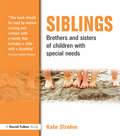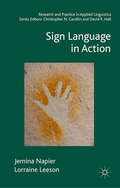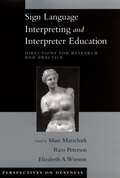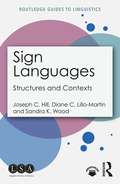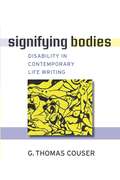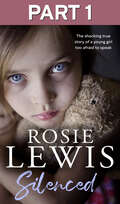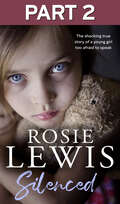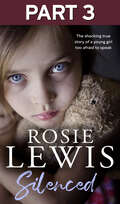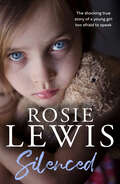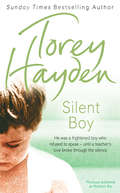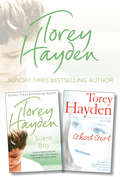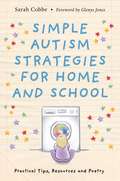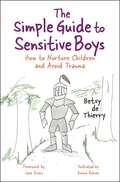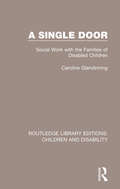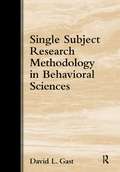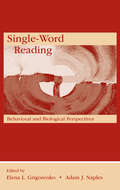- Table View
- List View
Shrinking the Smirch: The Young People's Edition
by Jo Johnson'Shrinking the Smirch: The Young People's Edition' is a workbook to help young people manage stress, gain confidence, resist peer pressure and stay healthy. This book helps young people cope with the usual challenges of being a young adults including anxiety, peer pressure, exam stress, bullying, social media, etc. and is also appropriate for clinical conditions such as panic, eating problems, self harm and low mood. This resource is about the mind, what goes on in your head and coping with all the pressure and challenges young people have to face at home and school. This unique workbook for teenagers asks you to pretend these tricky thoughts and feelings are coming from a smirch, an unkind imaginary friend, a mind bully who wants to pull you into the pit of despair. This resource gives a lot of ideas about how you can beat this mind bully and cope better with all the thoughts and feelings that make you anxious, lonely and upset. It has been written with the help of a diverse group of young people who have shared their stories so you can see you are not alone and that there are things you can do to make life feel better. Jo Johnson has been working as a neuropsychologist for eighteen years. She worked for two decades within the NHS but now works as an independent consultant teaching and writing for several of the national neurology charities. Her specialist interests include brain injury, dementia and multiple sclerosis. She has written several books to meet the needs of children who have a parent with a neurological diagnosis including 'How to talk to your kids about MS' and 'My parent has a brain injury; a guide for young people'.
Siblings: Brothers and Sisters of Children with Special Needs
by Kate StrohmThe siblings of children with special needs are often the overlooked ones in families struggling to cope. Kate Strohm is an experienced health professional and journalist who has sister with cerebral palsy. In this book she shares the story of her journey from confusion and distress to understanding and acceptance. She provides a forum for other siblings to describe their own journeys. Kate also provides strategies that siblings themselves, parents and practitioner can use to support the brothers and sisters of children with special.
Siblings: Brothers and Sisters of Children with Special Needs
by Kate StrohmThe siblings of children with special needs are often the overlooked ones in families struggling to cope. Kate Strohm is an experienced health professional and journalist who has sister with cerebral palsy. In this book she shares the story of her journey from confusion and distress to understanding and acceptance. She provides a forum for other siblings to describe their own journeys. Kate also provides strategies that siblings themselves, parents and practitioner can use to support the brothers and sisters of children with special.
Sign Language in Action (Research and Practice in Applied Linguistics)
by Jemina Napier Lorraine LeesonThis book defines the notion of applied sign linguistics by drawing on data from projects that have explored sign language in action in various domains. The book gives professionals working with sign languages, signed language teachers and students, research students and their supervisors, authoritative access to current ideas and practice.
Sign Language Interpreting and Interpreter Education: Directions for Research and Practice (Perspectives on Deafness)
by Elizabeth A. Winston Patricia Sapere Carol M. Convertino Rosemarie Seewagen Christine Monikowski Marc Marschark Rico PetersonMore the 1.46 million people in the United States have hearing losses in sufficient severity to be considered deaf; another 21 million people have other hearing impairments. For many deaf and hard-of-hearing individuals, sign language and voice interpreting is essential to their participation in educational programs and their access to public and private services. However, there is less than half the number of interpreters needed to meet the demand, interpreting quality is often variable, and there is a considerable lack of knowledge of factors that contribute to successful interpreting. Perhaps it is not surprising, then, that a study by the National Association of the Deaf (NAD) found that 70% of the deaf individuals are dissatisfied with interpreting quality. Because recent legislation in the United States and elsewhere has mandated access to educational, employment, and other contexts for deaf individuals and others with hearing disabilities, there is an increasing need for quality sign language interpreting. It is in education, however, that the need is most pressing, particularly because more than 75% of deaf students now attend regular schools (rather than schools for the deaf), where teachers and classmates are unable to sign for themselves. In the more than 100 interpreter training programs in the U.S. alone, there are a variety of educational models, but little empirical information on how to evaluate them or determine their appropriateness in different interpreting and interpreter education-covering what we know, what we do not know, and what we should know. Several volumes have covered interpreting and interpreter education, there are even some published dissertations that have included a single research study, and a few books have attempted to offer methods for professional interpreters or interpreter educators with nods to existing research. This is the first volume that synthesizes existing work and provides a coherent picture of the field as a whole, including evaluation of the extent to which current practices are supported by validating research. It will be the first comprehensive source, suitable as both a reference book and a textbook for interpreter training programs and a variety of courses on bilingual education, psycholinguistics and translation, and cross-linguistic studies.
Sign Languages: Structures and Contexts (Routledge Guides to Linguistics #13)
by Joseph C. Hill Diane C. Lillo-Martin Sandra K. WoodSign Languages: Structures and Contexts provides a succinct summary of major findings in the linguistic study of natural sign languages. Focusing on American Sign Language (ASL), this book: offers a comprehensive introduction to the basic grammatical components of phonology, morphology, and syntax with examples and illustrations; demonstrates how sign languages are acquired by Deaf children with varying degrees of input during early development, including no input where children create a language of their own; discusses the contexts of sign languages, including how different varieties are formed and used, attitudes towards sign languages, and how language planning affects language use; is accompanied by e-resources, which host links to video clips. Offering an engaging and accessible introduction to sign languages, this book is essential reading for students studying this topic for the first time with little or no background in linguistics.
Sign Languages (PDF)
by Joseph C. Hill Diane C. Lillo-Martin Sandra K. WoodSign Languages: Structures and Contexts provides a succinct summary of major findings in the linguistic study of natural sign languages. Focusing on American Sign Language (ASL), this book: offers a comprehensive introduction to the basic grammatical components of phonology, morphology, and syntax with examples and illustrations; demonstrates how sign languages are acquired by Deaf children with varying degrees of input during early development, including no input where children create a language of their own; discusses the contexts of sign languages, including how different varieties are formed and used, attitudes towards sign languages, and how language planning affects language use; is accompanied by e-resources, which host links to video clips. Offering an engaging and accessible introduction to sign languages, this book is essential reading for students studying this topic for the first time with little or no background in linguistics.
Signifying Bodies: Disability in Contemporary Life Writing (Corporealities: Discourses Of Disability)
by G. T Couser"Thomas Couser's Signifying Bodies comes at a crucial moment when debates about physician assisted suicide, genetic engineering, and neo-natal screening are raising the question of what constitutes a 'life worth living' for persons with disabilities. Couser's work engages these debates by exploring the extensive number of personal narratives by or about persons with disabilities. As Couser brilliantly demonstrates through synoptic readings, these works challenge the 'preferred rhetorics' by which such narratives are usually written (triumphalist, gothic, nostalgic) while making visible the variegated nature of embodied life." ---Michael Davidson, University of California, San Diego "Signifying Bodies shows us that life writing about disability is . . . everywhere. . . . From obituary to documentary film to ethnography to literary memoir to the law, the book casts a wide net, detailing how various written and filmed responses to disability both enact and resist conventional narrative patterns. [This] not only broadens our idea about where to look for life writing, but also demonstrates how thoroughly stereotypes about disability mediate our social and artistic languages---even when an author has (so-called) the best intentions." ---Susannah B. Mintz, Skidmore College Memoirs have enjoyed great popularity in recent years, experiencing significant sales, prominent reviews, and diverse readerships. Signifying Bodies shows that at the heart of the memoir phenomenon is our fascination with writing that focuses on what it means to live in, or be, an anomalous body---in other words, what it means to be disabled. Previous literary accounts of the disabled body have often portrayed it as a stable entity possibly signifying moral deviance or divine disfavor, but contemporary writers with disabilities are defining themselves and depicting their bodies in new ways. Using the insights of disability studies and source material ranging from the Old and New Testaments to the works of authors like Lucy Grealy and Simi Linton and including contemporary films such as Million Dollar Baby, G. Thomas Couser sheds light on a broader cultural phenomenon, exploring topics such as the ethical issues involved in disability memoirs, the rhetorical patterns they frequently employ, and the complex relationship between disability narrative and disability law. G. Thomas Couser is Professor of English at Hofstra University.
Silenced: The Shocking True Story Of A Young Girl Too Afraid To Speak
by Rosie LewisPART 1 OF 3 A family with a dark secret.A child who refuses to speak.Rosie must help her before it’s too late.
Silenced: The Shocking True Story Of A Young Girl Too Afraid To Speak
by Rosie LewisPART 2 OF 3 A family with a dark secret.A child who refuses to speak.Rosie must help her before it’s too late.
Silenced: The Shocking True Story Of A Young Girl Too Afraid To Speak
by Rosie LewisPART 3 OF 3 A family with a dark secret.A child who refuses to speak.Rosie must help her before it’s too late.
Silenced: The Shocking True Story Of A Young Girl Too Afraid To Speak
by Rosie LewisA family with a dark secret.A child who refuses to speak.Rosie must help her before it’s too late.
Silent Boy: He Was A Frightened Boy Who Refused To Speak - Until A Teacher's Love Broke Through The Silence
by Torey HaydenFrom the author of Sunday Times bestsellers One Child and Ghost Girl comes a heartbreaking story of a boy trapped in silence and the teacher who rescued him.
Silent Boy and Ghost Girl 2-in-1 Collection
by Torey HaydenSunday Times bestselling author Torey Hayden is back with a combined volume of her deeply moving books Silent Boy and Ghost Girl, which each tell the true story of a teacher’s perseverance to rescue disturbed and trapped children from the darkness.
Simple Autism Strategies for Home and School: Practical Tips, Resources and Poetry
by Sarah CobbeOffering a unique overview of a child's point of view of life with autism, this guidebook will help parents and teachers better understand how this condition is experienced in day to day life. Organised by topic for easy reference, it explores the issues that can arise in everyday situations from toilet training to homework.Learning points, situation-specific activities, and further resources offer practical guidance, while discussion tools such as original poetry illustrate the perspectives of children with autism. Concise and accessible, this book takes a creative approach to understanding autism, and will be an invaluable reference book.
Simple Autism Strategies for Home and School: Practical Tips, Resources and Poetry
by Sarah CobbeOffering a unique overview of a child's point of view of life with autism, this guidebook will help parents and teachers better understand how this condition is experienced in day to day life. Organised by topic for easy reference, it explores the issues that can arise in everyday situations from toilet training to homework.Learning points, situation-specific activities, and further resources offer practical guidance, while discussion tools such as original poetry illustrate the perspectives of children with autism. Concise and accessible, this book takes a creative approach to understanding autism, and will be an invaluable reference book.
The Simple Guide to Sensitive Boys: How to Nurture Children and Avoid Trauma
by Betsy De Thierry Emma Reeves Jane EvansWhat do Pablo Picasso, Prince and Martin Luther King Jr have in common? All have been described as having been highly sensitive boys and all grew up to be outstanding, sensitive men. Too often, adults think of sensitive boys as shy, anxious and inhibited. They are measured against society's ideas about 'manliness' -- that all boys are sociable, resilient and have endless supplies of energy. This highly readable guide is for any adult wanting to know how to understand and celebrate sensitive boys. It describes how thinking about boys in such old-fashioned ways can cause great harm, and make a difficult childhood all the more painful. The book highlights the real strengths shared by many sensitive boys - of being compassionate, highly creative, thoughtful, fiercely intelligent and witty. It also flips common negative clichés about sensitive boys being shy, anxious and prone to bullying to ask instead: what we can do to create a supportive environment in which they will flourish? Full of simple yet sage advice, this book will help you to encourage boys to embrace their individuality, find their own place in the world, and to be the best they can be.
The Simple Guide to Sensitive Boys: How to Nurture Children and Avoid Trauma (PDF)
by Betsy De Thierry Emma Reeves Jane EvansWhat do Pablo Picasso, Prince and Martin Luther King Jr have in common? All have been described as having been highly sensitive boys and all grew up to be outstanding, sensitive men. Too often, adults think of sensitive boys as shy, anxious and inhibited. They are measured against society's ideas about 'manliness' -- that all boys are sociable, resilient and have endless supplies of energy. This highly readable guide is for any adult wanting to know how to understand and celebrate sensitive boys. It describes how thinking about boys in such old-fashioned ways can cause great harm, and make a difficult childhood all the more painful. The book highlights the real strengths shared by many sensitive boys - of being compassionate, highly creative, thoughtful, fiercely intelligent and witty. It also flips common negative clichés about sensitive boys being shy, anxious and prone to bullying to ask instead: what we can do to create a supportive environment in which they will flourish? Full of simple yet sage advice, this book will help you to encourage boys to embrace their individuality, find their own place in the world, and to be the best they can be.
Simplified Signs: A Manual Sign-Communication System for Special Populations, Volume 1.
by John D. Bonvillian Nicole Kissane Lee Tracy T. Dooley Filip T. LonckeSimplified Signs presents a system of manual sign communication intended for special populations who have had limited success mastering spoken or full sign languages. It is the culmination of over twenty years of research and development by the authors. The Simplified Sign System has been developed and tested for ease of sign comprehension, memorization, and formation by limiting the complexity of the motor skills required to form each sign, and by ensuring that each sign visually resembles the meaning it conveys. Volume 1 outlines the research underpinning and informing the project, and places the Simplified Sign System in a wider context of sign usage, historically and by different populations. Volume 2 presents the lexicon of signs, totalling approximately 1000 signs, each with a clear illustration and a written description of how the sign is formed, as well as a memory aid that connects the sign visually to the meaning that it conveys. While the Simplified Sign System originally was developed to meet the needs of persons with intellectual disabilities, cerebral palsy, autism, or aphasia, it may also assist the communication needs of a wider audience – such as healthcare professionals, aid workers, military personnel, travellers or parents, and children who have not yet mastered spoken language. The system also has been shown to enhance learning for individuals studying a foreign language. Lucid and comprehensive, this work constitutes a valuable resource that will enhance the communicative interactions of many different people, and will be of great interest to researchers and educators alike.
Simplified Signs: A Manual Sign-Communication System for Special Populations, Volume 2.
by John D. Bonvillian Nicole Kissane Lee Tracy T. Dooley Filip T. LonckeSimplified Signs presents a system of manual sign communication intended for special populations who have had limited success mastering spoken or full sign languages. It is the culmination of over twenty years of research and development by the authors. The Simplified Sign System has been developed and tested for ease of sign comprehension, memorization, and formation by limiting the complexity of the motor skills required to form each sign, and by ensuring that each sign visually resembles the meaning it conveys. Volume 1 outlines the research underpinning and informing the project, and places the Simplified Sign System in a wider context of sign usage, historically and by different populations. Volume 2 presents the lexicon of signs, totalling approximately 1000 signs, each with a clear illustration and a written description of how the sign is formed, as well as a memory aid that connects the sign visually to the meaning that it conveys. While the Simplified Sign System originally was developed to meet the needs of persons with intellectual disabilities, cerebral palsy, autism, or aphasia, it may also assist the communication needs of a wider audience – such as healthcare professionals, aid workers, military personnel, travellers or parents, and children who have not yet mastered spoken language. The system also has been shown to enhance learning for individuals studying a foreign language. Lucid and comprehensive, this work constitutes a valuable resource that will enhance the communicative interactions of many different people, and will be of great interest to researchers and educators alike.
A Single Door: Social Work with the Families of Disabled Children (Routledge Library Editions: Children and Disability)
by Caroline GlendinningFirst published in 1986, this study explores the increased public concern with policies of ‘community care’ and their effects on informal carers, at that time. It looks at the widespread evidence that one particular group of informal carers- parents looking after their severely disabled child- lack information, advice and a co-ordinated pattern of supporting services. The author, who carried out research on disabled children and their families for a number of years, describes in detail a low-cost experimental project in which specialist social workers set out to remedy these shortcomings. Drawing on the results of this particular study, the author argues strongly for widespread assignment of ‘key’ social workers to this and other groups of informal carers. Despite being written in the mid-1980s, this book discusses topic that will still be of interest and use today.
A Single Door: Social Work with the Families of Disabled Children (Routledge Library Editions: Children and Disability #8)
by Caroline GlendinningFirst published in 1986, this study explores the increased public concern with policies of ‘community care’ and their effects on informal carers, at that time. It looks at the widespread evidence that one particular group of informal carers- parents looking after their severely disabled child- lack information, advice and a co-ordinated pattern of supporting services. The author, who carried out research on disabled children and their families for a number of years, describes in detail a low-cost experimental project in which specialist social workers set out to remedy these shortcomings. Drawing on the results of this particular study, the author argues strongly for widespread assignment of ‘key’ social workers to this and other groups of informal carers. Despite being written in the mid-1980s, this book discusses topic that will still be of interest and use today.
Single Subject Research Methodology in Behavioral Sciences
by Jennifer R. Ledford David L. GastThis book is written for student researchers, practitioners, and university faculty who are interested in answering applied research questions and objectively evaluating educational and clinical practices. The basic tenet of single-subject research methodology is that the individual is of primary importance and that each individual study participant serves as his or her own control. It is because of this focus on the individual that clinicians and educators have been using single-subject research designs for over 40 years to answer applied research questions. Although the methodology has its roots in behavioral psychology and applied behavioral analysis, it has been used by applied researchers across a variety of disciplines such as special education, speech and communication sciences, language and literacy, therapeutic recreation, occupational therapy, and social work. Key features include the following: Applied Focus – More than any other text, this one focuses on the nuts and bolts of how to use single-subject research in constructing one’s research project or in evaluating one’s professional practice. Numerous and Varied Examples – The book abounds in examples from special education and other disciplines and populations within the applied research literature. Reader Friendly – The text is written in a reader friendly style, features sample data sheets and graphic displays, and includes detailed guidelines for conducting visual analysis of graphic data. Expertise – The author’s long and distinguished career in teaching single-subject research is augmented in this book by contributions from other experts in the field.
Single Subject Research Methodology in Behavioral Sciences
by Jennifer R. Ledford David L. GastThis book is written for student researchers, practitioners, and university faculty who are interested in answering applied research questions and objectively evaluating educational and clinical practices. The basic tenet of single-subject research methodology is that the individual is of primary importance and that each individual study participant serves as his or her own control. It is because of this focus on the individual that clinicians and educators have been using single-subject research designs for over 40 years to answer applied research questions. Although the methodology has its roots in behavioral psychology and applied behavioral analysis, it has been used by applied researchers across a variety of disciplines such as special education, speech and communication sciences, language and literacy, therapeutic recreation, occupational therapy, and social work. Key features include the following: Applied Focus – More than any other text, this one focuses on the nuts and bolts of how to use single-subject research in constructing one’s research project or in evaluating one’s professional practice. Numerous and Varied Examples – The book abounds in examples from special education and other disciplines and populations within the applied research literature. Reader Friendly – The text is written in a reader friendly style, features sample data sheets and graphic displays, and includes detailed guidelines for conducting visual analysis of graphic data. Expertise – The author’s long and distinguished career in teaching single-subject research is augmented in this book by contributions from other experts in the field.
Single-Word Reading: Behavioral and Biological Perspectives
by Elena L. Grigorenko Adam J. NaplesAs the first title in the new series, New Directions in Communication Disorders Research: Integrative Approaches, this volume discusses a unique phenomenon in cognitive science, single-word reading, which is an essential element in successful reading competence. Single-word reading is an interdisciplinary area of research that incorporates phonolog

